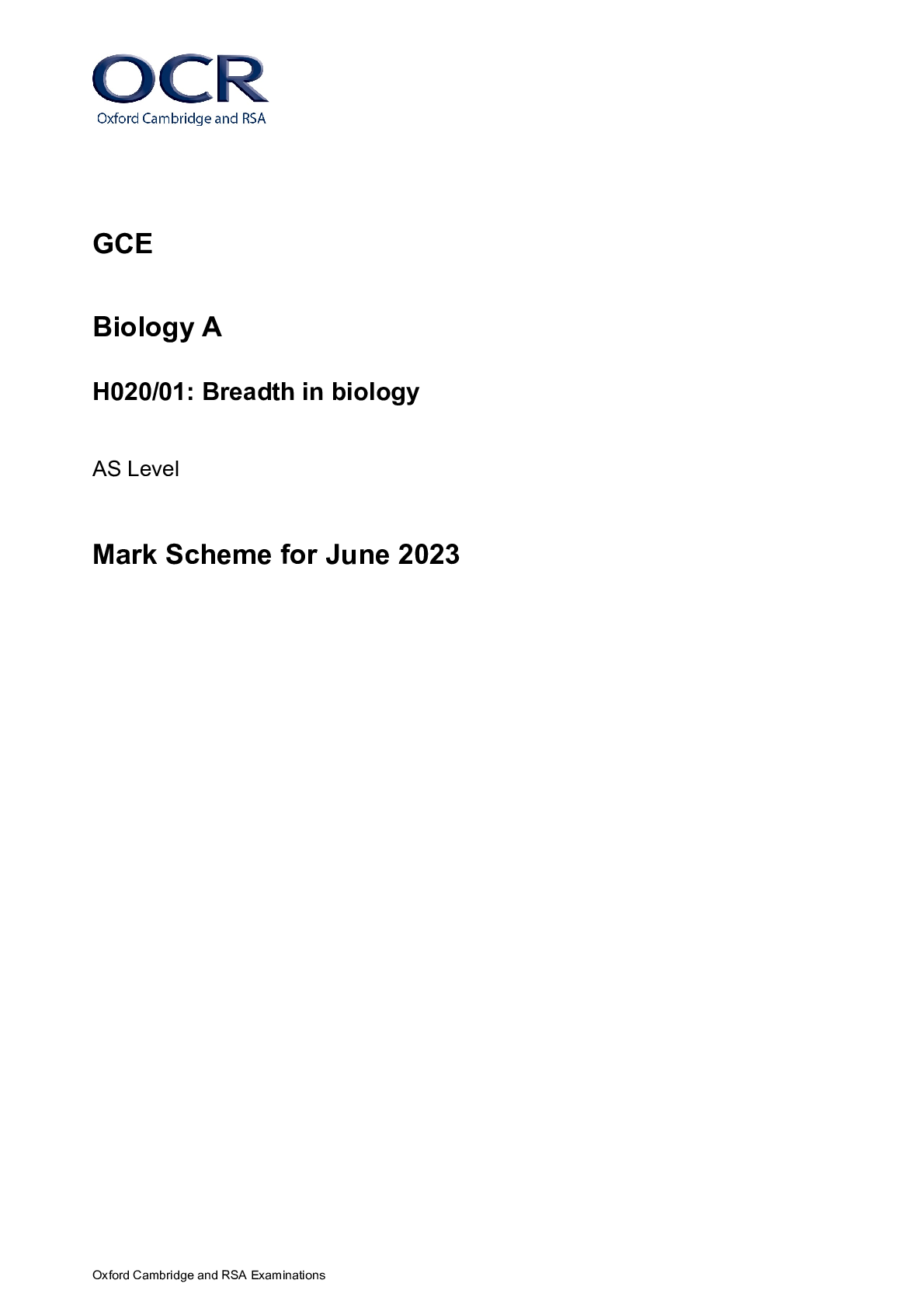Religious Studies > MARK SCHEMES > GCE Religious Studies H173/04: Developments in Islamic thought Advanced Subsidiary GCE Mark Scheme f (All)
GCE Religious Studies H173/04: Developments in Islamic thought Advanced Subsidiary GCE Mark Scheme for November 2020
Document Content and Description Below
GCE Religious Studies H173/04: Developments in Islamic thought Advanced Subsidiary GCE Mark Scheme for November 2020 Oxford Cambridge and RSA Examinations GCE Religious Studies H173/04: Deve ... lopments in Islamic thought Advanced Subsidiary GCE Mark Scheme for November 2020Oxford Cambridge and RSA Examinations OCR (Oxford Cambridge and RSA) is a leading UK awarding body, providing a wide range of qualifications to meet the needs of candidates of all ages and abilities. OCR qualifications include AS/A Levels, Diplomas, GCSEs, Cambridge Nationals, Cambridge Technicals, Functional Skills, Key Skills, Entry Level qualifications, NVQs and vocational qualifications in areas such as IT, business, languages, teaching/training, administration and secretarial skills. It is also responsible for developing new specifications to meet national requirements and the needs of students and teachers. OCR is a not-for-profit organisation; any surplus made is invested back into the establishment to help towards the development of qualifications and support, which keep pace with the changing needs of today’s society. This mark scheme is published as an aid to teachers and students, to indicate the requirements of the examination. It shows the basis on which marks were awarded by examiners. It does not indicate the details of the discussions which took place at an examiners’ meeting before marking commenced. All examiners are instructed that alternative correct answers and unexpected approaches in candidates’ scripts must be given marks that fairly reflect the relevant knowledge and skills demonstrated. Mark schemes should be read in conjunction with the published question papers and the report on the examination. © OCR 20202 Indicative content – Responses might include: Guidance 1. 1. Evaluate Qur’an 21:22 as proof of God’s oneness. AO1 Candidates may demonstrate knowledge and understanding through the use of some of the following ideas: • an explanation of the Islamic concept of the oneness of God (tawhid), and the idea of associating others with God (shirk) as the greatest sin a Muslim can commit • the Arabic word Allah means ‘the God’ and this shows that the oneness of God is a fundamental belief in Islam • the Qur’an 21, the prophets (An-nabiya), focuses on the story of Moses and refers to Abraham’s fight against idolatry • the Qur’an 21:22 states that there is only one God and that confusion would reign if this were not the case • the concept of the oneness of God (tawhid) is summed up in the Islamic testimony of faith, the first pillar of Islam (shahadah), which states that there is only one God and that Muhammad (pbuh) is his messenger • the importance of other aspects of Islam, such as prophethood and belief in the Qur’an as the ‘words of Allah’, which are based on the concept of God’s oneness. AO2 Candidates may demonstrate evaluation and analysis through the use of some of the following arguments. • Some candidates might argue that the Qur’an 21:22 is proof of God’s oneness because: o the Qur’an 21:22 is found in the Qur’an, which all Muslims accept is the ‘words of Allah’. As the verse refers to the oneness of God it can’t be questioned so must be regarded as proof o the end of the verse suggests that God is above those who attribute other qualities to God, underlining the idea that God’s oneness cannot be questioned o the Qur’an 21 is primarily about the previous prophets. It highlights the monotheistic message that all prophets preached which adds to the reliability of the claim that God is one, as shown in verse 22 o verse 22 refers to the confusion that would be caused if there was more than one God and there does seem to be logic behind this argument. For example, this refers to the argument that you cannot have two equally omnipotent powers o other religions also believe in the oneness of God which supports the claim in 21:22. • Some candidates might argue that the Qur’an 21:22 is not proof of God’s oneness because: Qur’an (Yusuf Ali translation): 21:22. If there were, in the heavens and the earth, other gods besides Allah, there would have been confusion in both! but glory to Allah, the Lord of the Throne: (High is He) above what they attribute to Him!3 Indicative content – Responses might include: Guidance o one verse of the Qur’an should not be taken in isolation to suggest it is proof of God’s oneness; the whole of the Qur’an should be considered instead o this verse focuses on an ‘if’ hypothesis and does not cite visible proofs or evidence o there are much stronger pieces of evidence. For example, arguments based on empirical evidence, such as teleological or cosmological arguments, are arguably more convincing for many people. • Some candidates may combine these views and argue that as the Qur’an is the ‘word of God’ it can be regarded as proof of God’s oneness. However, it is not sufficient proof on its own and needs to be used in conjunction with other sources.4 Indicative content – Responses might include: Guidance 2. 2. ‘Scriptural sources are less reliable than non-scriptural sources for the formation of Islamic law.’ Discuss. AO1 Candidates may demonstrate knowledge and understanding through the use of some of the following ideas: • Islamic law has the purpose of guiding Muslims along the ‘straight path’ by helping them to live according to the will of Allah • there are four law schools that were responsible for the formation of Islamic law. These are the Malikite, Hanifite, Shafi’ite and Hanbali law schools • the reason for the emergence may include a discussion of the debate over which source should be used in the formation of Islamic law • scriptural refers to the sacred writings of a religion. In Islam scriptural sources are the Qur’an, as the primary source, and the Sunna, as a secondary source • non-scriptural sources, used in the formation of Islamic law, are consensus, analogy, reasoning and custom • the term ‘reliable’, in this context, can be viewed as the most trustworthy or authentic. AO2 Candidates may demonstrate evaluation and analysis through the use of some of the following arguments: • Some candidates might argue that scriptural sources are less reliable than non-scriptural sources because: o the Qur’an was revealed in a specific time period and modern society is very different. Even though the Qur’an is considered a direct revelation from God it doesn’t refer specifically to many modern issues and so it is likely to be less reliable than non-scriptural sources such as analogy o not all hadiths are regarded as authentic so this weakens the overall reliability of using the Sunna as a source of Islamic law o although Islamic scripture is regarded as the words of Allah it can still be interpreted in different ways, making it less reliable than non-scriptural sources such as consensus o Shi’a and Sufi Muslims regard it as essential to use an interpreter in the form of an Imam to guide them, suggesting the text alone may give less reliable guidance o for example, some Muslims claim to base their actions on scripture (the Qur’an) yet they carry out actions that most Muslims consider to be un-Islamic in character, suggesting the scriptural sources are unreliable. • Some candidates might argue that non-scriptural sources are less reliable than scriptural sources because:5 Indicative content – Responses might include: Guidance o custom is based the rulings and behaviour of the early Muslim community. This means that there are many issues that were not faced by the community so their judgements may not be relevant for society today. Although the same could be argued about scriptural sources, nevertheless the Qur’an is directly from Allah which makes it more reliable o analogy involves the use of human interpretation. Arguably, when it comes to the formation of religious laws, the use of human reason makes it less reliable as humans are fallible o all four Sunni law schools used scriptural sources in the formation of Islamic law. However, they disagreed on which, if any, non-scriptural sources should be used. This suggests that they are not as reliable as scriptural sources o there is also a difference between Sunni and Shi’a law schools in the use of analogy (ijma) by Sunnis and reasoning (aql) by Shi’a interpreters o scriptural sources are regarded as unchanged texts since the early years of Islam, so may be more reliable accounts of what the Prophet (pbuh) taught than later interpretations. • Some candidates may combine these views and argue that ... o as both scriptural and non-scriptural sources have been used in the formation of Islamic law they may be considered to be equally reliable o as there are, arguably, flaws to using both scriptural and non-scriptural sources when forming Islamic law none can be considered more or less reliable than the other. They are both needed if Islamic law is to be reliable.6 Indicative content – Responses might include: Guidance 3. ‘There is no difference between a prophet (nabi) and a messenger (rasul), in Islam.’ Discuss. AO1 Candidates may demonstrate knowledge and understanding through the use of some of the following ideas: • prophets (nabi) bring God’s message to people. According to the Qur’an every prophet was given God’s word for their generation • messages were distorted so new prophets were sent with another version of the original message • 25 prophets are named in the Qur’an, including Adam, Ibrahim (Abraham), Musa (Moses) and Isa (Jesus). Muhammad is the ‘seal of the prophets’ • a messenger (rasul) is always a prophet but a prophet is not always a messenger • the belief in prophets and messengers is one of the six core beliefs in Islam and comes under the heading of prophecy (risalah) • Allah sent messengers and prophets out of love for Allah’s creation AO2 Candidates may demonstrate evaluation and analysis through the use of some of the following arguments. • some candidates might argue that it is true to say that there is no difference between prophets and messengers in Islam because: o all prophets and messengers are just human beings which means that they are ultimately the same o whether the message being delivered is a new law or the continuation of an old one it comes from the same source, Allah, so there is arguably no difference between prophets and messengers as they are all bringing divine messages to humanity o Muhammad (pbuh) was both a prophet and messenger. As he is the only human to be mentioned in the Islamic declaration of faith (shahadah), this means that both roles are of equal importance and that there is no difference between the two o many previous messengers in Islam were also regarded as prophets, including Ibrahim (Abraham), Musa (Moses) and Isa (Jesus) o Muhammad (pbuh) referred to previous prophets and messengers and did not distinguish between them.7 Indicative content – Responses might include: Guidance • some candidates might argue that there is a significant difference between prophets and messengers in Islam because: o all messengers (rasul) are prophets but not all prophets (nabi) are messengers. This shows that there is a significant difference between the two o the fact that both messengers and prophets exist independently supports the idea that there is a significant difference between the two o messengers receive their messages through the angel Jibril and this isn’t necessarily the case with prophets. This could suggest that there is a significant difference between the two roles o some early prophets in Islam are not referred to as messengers, including Adam, Idris (Enoch) and Yacub (Jacob) o some Muslims refer to messengers bringing a message to disbelieving peoples, and prophets bringing teachings to believing peoples who nevertheless needed more guidance. • Some candidates may combine these views and argue that: o both messengers (rasul) and prophets (nabi) taught about Allah’s guidance, not their own views, and were not worshipped themselves, so the distinction between the two may be irrelevant o the roles often merged and the terms are not used exclusively.1 Level (Mark) Levels of Response for AS Level Religious Studies: Assessment Objective 1 (AO1) Demonstrate knowledge and understanding of religion and belief, including: • Religious, philosophical and/or ethical thought and teaching • Approaches to the study of religion and belief Note: The descriptors below must be considered in the context of all listed strands of Assessment Objectives 1 (AO1) and the indicative content in the mark scheme. 5 (13– 15) A very good demonstration of knowledge and understanding in response to the question : • focuses on the precise question throughout • very good selection of relevant material which is used appropriately • accurate, and detailed knowledge which demonstrates very good understanding through either the breadth or depth of material used • accurate and appropriate use of technical terms and subject vocabulary. • a very good range of scholarly views, academic approaches, and/or sources of wisdom and authority are used to demonstrate knowledge and understanding 4 (10– 12) A good demonstration of knowledge and understanding in response to the question: • addresses the question well • good selection of relevant material, used appropriately on the whole • mostly accurate knowledge which demonstrates good understanding of the material used, which should have reasonable amounts of depth or breadth • mostly accurate and appropriate use of technical terms and subject vocabulary. • a good range of scholarly views, academic approaches, and/or sources of wisdom and authority are used to demonstrate knowledge and understanding 3 (7–9) A satisfactory demonstration of knowledge and understanding in response to the question: • generally addresses the question • mostly sound selection of mostly relevant material • some accurate knowledge which demonstrates sound understanding through the material used, which might however be lacking in depth or breadth • generally appropriate use of technical terms and subject vocabulary. A satisfactory range of scholarly views, academic approaches, and/or sources of wisdom and authority are used to demonstrate knowledge and understanding with only partial success 2 (4–6) A basic demonstration of knowledge and understanding in response to the question: • might address the general topic rather than the question directly • limited selection of partially relevant material • some accurate, but limited, knowledge which demonstrates partial understanding • some accurate, but limited, use of technical terms and appropriate subject vocabulary. a limited range of scholarly views, academic approaches, and/or sources of wisdom and authority are used to demonstrate knowledge and understanding with little success 1 (1–3) A weak demonstration of knowledge and understanding in response to the question: • almost completely ignores the question • very little relevant material selected • knowledge very limited, demonstrating little understanding • very little use of technical terms or subject vocabulary. • very little or no use of scholarly views, academic approaches and/or sources of wisdom and authority to demonstrate knowledge and understanding 0 (0) No creditworthy response2 Level (Mark) Levels of Response for AS Level Religious Studies: Assessment Objective 2 (AO2) Analyse and evaluate aspects of, and approaches to, religion and belief, including their significance, influence and study Note: The descriptors below must be considered in the context of all elements of Assessment Objective 2 (AO2) and the indicative content in the mark scheme. 5 (13–15) A very good demonstration of analysis and evaluation in response to the question: • clear and convincing argument • successful and clear analysis and evaluation • views very well stated, coherently developed and justified • answers the question set competently • accurate and appropriate use of technical terms and subject vocabulary. • a very good range of scholarly views, academic approaches and sources of wisdom and authority used to support analysis and evaluation Assessment of Extended Response: There is a well–developed and sustained line of reasoning which is coherent, relevant and logically structured. 4 (10–12) A good demonstration of analysis and evaluation in response to the question: • argument is generally successful and clear • generally successful analysis and evaluation • views well stated, with some development and justification • answers the question set well • mostly accurate and appropriate use of technical terms and subject vocabulary. • a good range of scholarly views, academic approaches and sources of wisdom and authority are used to support analysis and evaluation Assessment of Extended Response: There is a well–developed line of reasoning which is clear, relevant and logically structured 3 (7–9) A satisfactory demonstration of analysis and/evaluation in response to the question: • some successful argument • partially successful analysis and evaluation • views asserted but often not fully justified • mostly answers the set question • generally appropriate use of technical terms and subject vocabulary. • a satisfactory range of scholarly views, academic approaches and sources of wisdom and authority are used to support analysis and evaluation with only partial success Assessment of Extended Response: There is a line of reasoning presented which is mostly relevant and which has some structure. 2 (4–6) A basic demonstration of analysis and evaluation in response to the question: • some argument attempted, not always successful • little successful analysis and evaluation • views asserted but with little justification • only partially answers the question • some accurate, but limited, use of technical terms and appropriate subject vocabulary. • a limited range of scholarly views, academic approaches and sources of wisdom and authority to support analysis and evaluation with little success Assessment of Extended Response: There is a line of reasoning which has some relevance and which is presented with limited structure. 1 (1–3) A weak demonstration of analysis and evaluation in response to the question: • very little argument attempted • very little successful analysis and evaluation • views asserted with very little justification • unsuccessful in answering the question • very little use of technical terms or subject vocabulary. • very little or no use of scholarly views, academic approaches and sources of wisdom and authority to support analysis and evaluation Assessment of Extended Response: The information is communicated in a basic/unstructured way. 0 (0) No creditworthy response1 Annotations Annotation Meaning Level one – to be used at the end of each part of the response in the margin. Level two – to be used at the end of each part of the response in the margin. Level three – to be used at the end of each part of the response in the margin. Level four – to be used at the end of each part of the response in the margin. Level five – to be used at the end of each part of the response in the margin. (H573 only) Level six - to be used at the end of each part of the response in the margin. Highlighting a section of the response that is irrelevant to the awarding of the mark. Point has been seen and noted, e.g. where part of an answer is at the end of the script. SUBJECT–SPECIFIC MARKING INSTRUCTIONS H173, H573 AS and A Level Religious Studies Introduction Your first task as an Examiner is to become thoroughly familiar with the material on which the examination depends. You should ensure that you have copies of these materials: • the specification, especially the assessment objectives • the question paper and its rubrics • the mark scheme. Please ask for help or guidance whenever you need it. Your first point of contact is your Team Leader. Information and instructions for examiners The practice scripts provide you with examples of the standard of each band. The marks awarded for these scripts will have been agreed by the Lead Marker and Team Leaders.2 The specific task-related indicative content for each question will help you to understand how the band descriptors may be applied. However, this indicative content does not constitute the mark scheme: it is material that candidates might use, grouped according to each assessment objective tested by the question. It is hoped that candidates will respond to questions in a variety of ways. Rigid demands for ‘what must be a good answer’ would lead to a distorted assessment. Candidates’ answers must be relevant to the question. Beware of prepared answers that do not show the candidate’s thought and which have not been adapted to the thrust of the question. Beware also of answers where candidates attempt to reproduce interpretations and concepts that they have been taught but have only partially understood. Using the Mark Scheme Please study the Mark Scheme carefully. The Mark Scheme is an integral part of the process that begins with the setting of the question paper and ends with the awarding of grades. Question papers and Mark Schemes are developed in association with each other so that issues of differentiation and positive achievement can be addressed from the very start. This Mark Scheme is a working document; it is not exhaustive; it does not provide ‘correct’ answers. The Mark Scheme can only provide ‘best guesses’ about how the question will work out, and it is subject to revision after we have looked at a wide range of scripts. Please read carefully all the scripts in your allocation and make every effort to look positively for achievement throughout the ability range. Always be prepared to use the full range of marks. The Mark Scheme contains a description of possible/content only; all legitimate answers and approaches must be credited appropriately. Learners are expected to make use of scholarly views, academic approaches and sources of wisdom and authority to support their argument. The Levels of Response must be used in conjunction with the outlined indicative content. Assessment Objectives Two Assessment Objectives are being assessed in all questions: AO1 (Demonstrate knowledge and understanding of religion and belief) and AO2 (Analyse and evaluate aspects of, and approaches to, religion and belief, including their significance, influence and study). Responses are credited for AO1 for selection, detail and accuracy of the knowledge and understanding of religion and belief deployed. Responses are credited for AO2 for how well the response addresses the question, for candidates using their knowledge and understanding to draw, express and support conclusions in relation to the question posed. Candidates will be assessed on the quality of the conclusions and points they argue and the clarity and success of their argument. Levels of Response Questions in this paper are marked using a levels of response grid. When using this grid examiners must use a best fit approach. Where there are both strengths and weaknesses in a particular response or particularly imbalanced responses in terms of the assessment objectives, examiners must carefully consider which level is the best fit for the performance. Note that candidates can achieve different levels in each assessment objective, for example a Level 3 for AO1, and a Level 2 for AO2.3 Please note that the Assessment Objectives being assessed are listed at the top of the mark scheme. Where a candidate does not address all of the Assessment Objective strands listed, the candidate cannot achieve the top level of response. Assessment of Extended Response The GCE General Conditions of Recognition state that: GCE 5.1 In designing and setting the assessments for a GCE qualification which it makes available, or proposes to make available, and awarding organization must ensure that, taken together, those assessments include questions or tasks which allow Learners to - a) provide extended responses As such, the quality of extended responses are assessed in all questions. While marks are not specifically given for this, descriptors for extended responses can be found in the AO2 Levels of Response in italics.OCR (Oxford Cambridge and RSA Examinations) The Triangle Building Shaftesbury Road Cambridge CB2 8EA [Show More]
Last updated: 3 years ago
Preview 1 out of 14 pages

Buy this document to get the full access instantly
Instant Download Access after purchase
Buy NowInstant download
We Accept:

Reviews( 0 )
$7.50
Can't find what you want? Try our AI powered Search
Document information
Connected school, study & course
About the document
Uploaded On
Oct 07, 2022
Number of pages
14
Written in
All
Additional information
This document has been written for:
Uploaded
Oct 07, 2022
Downloads
0
Views
98





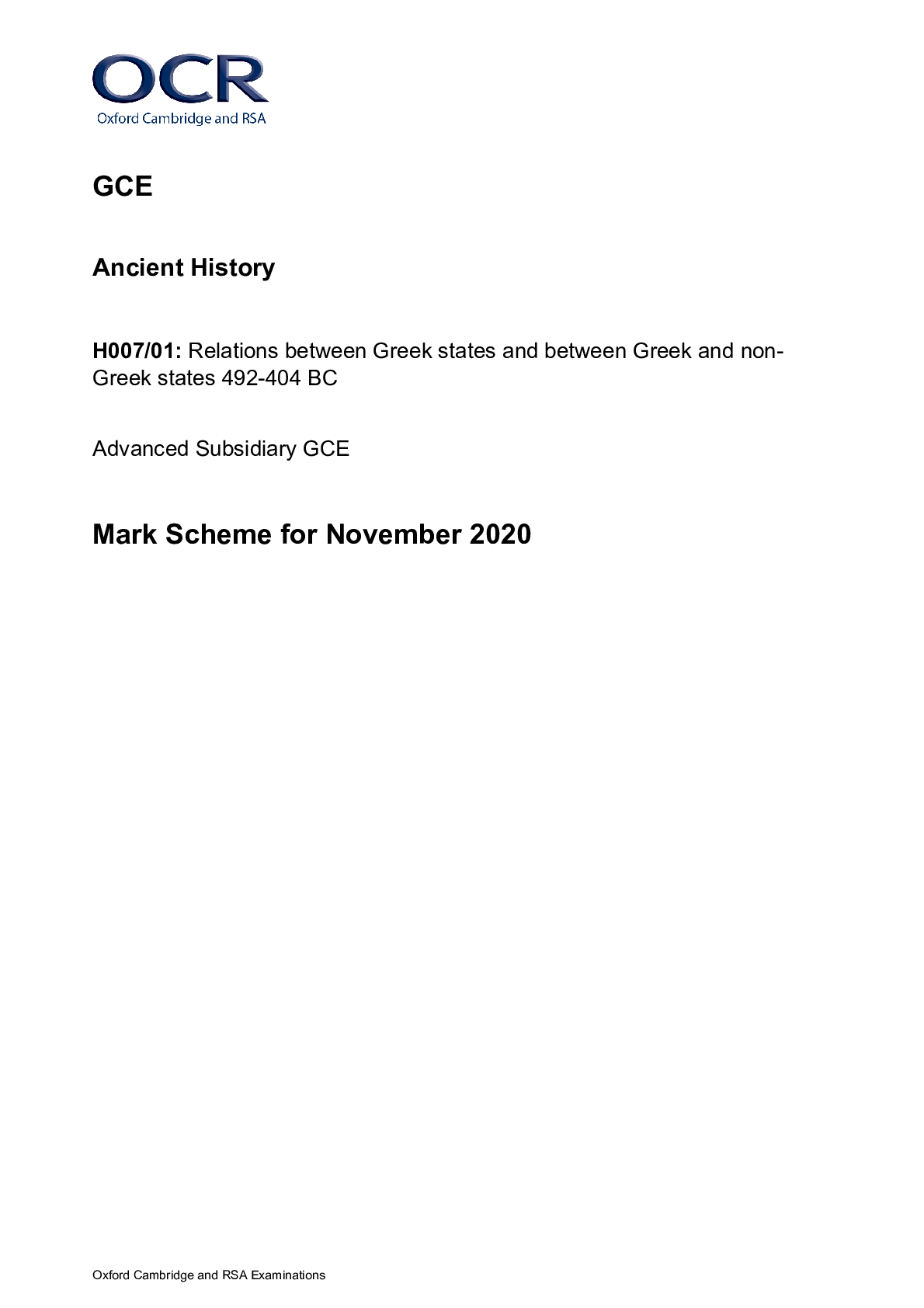
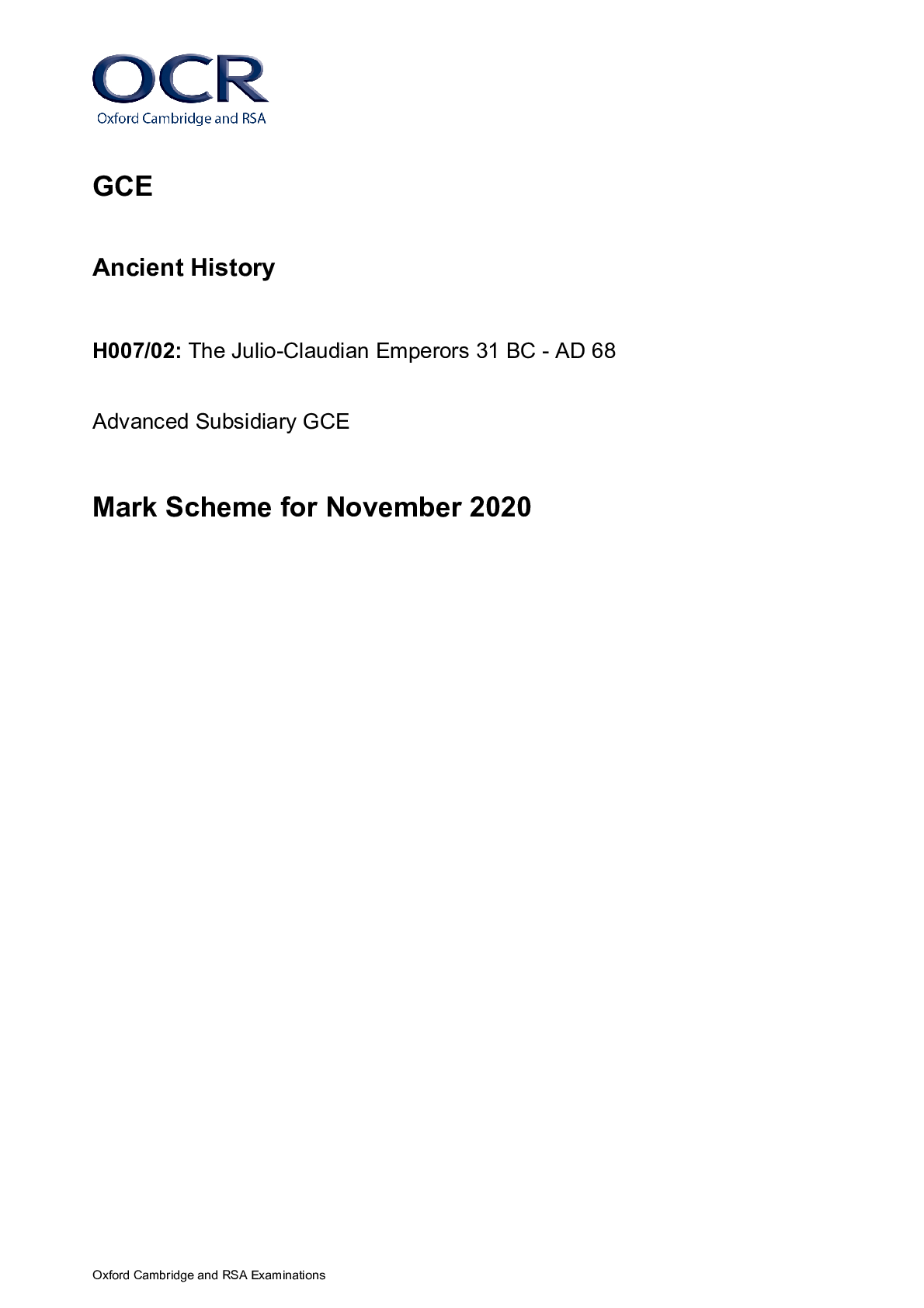



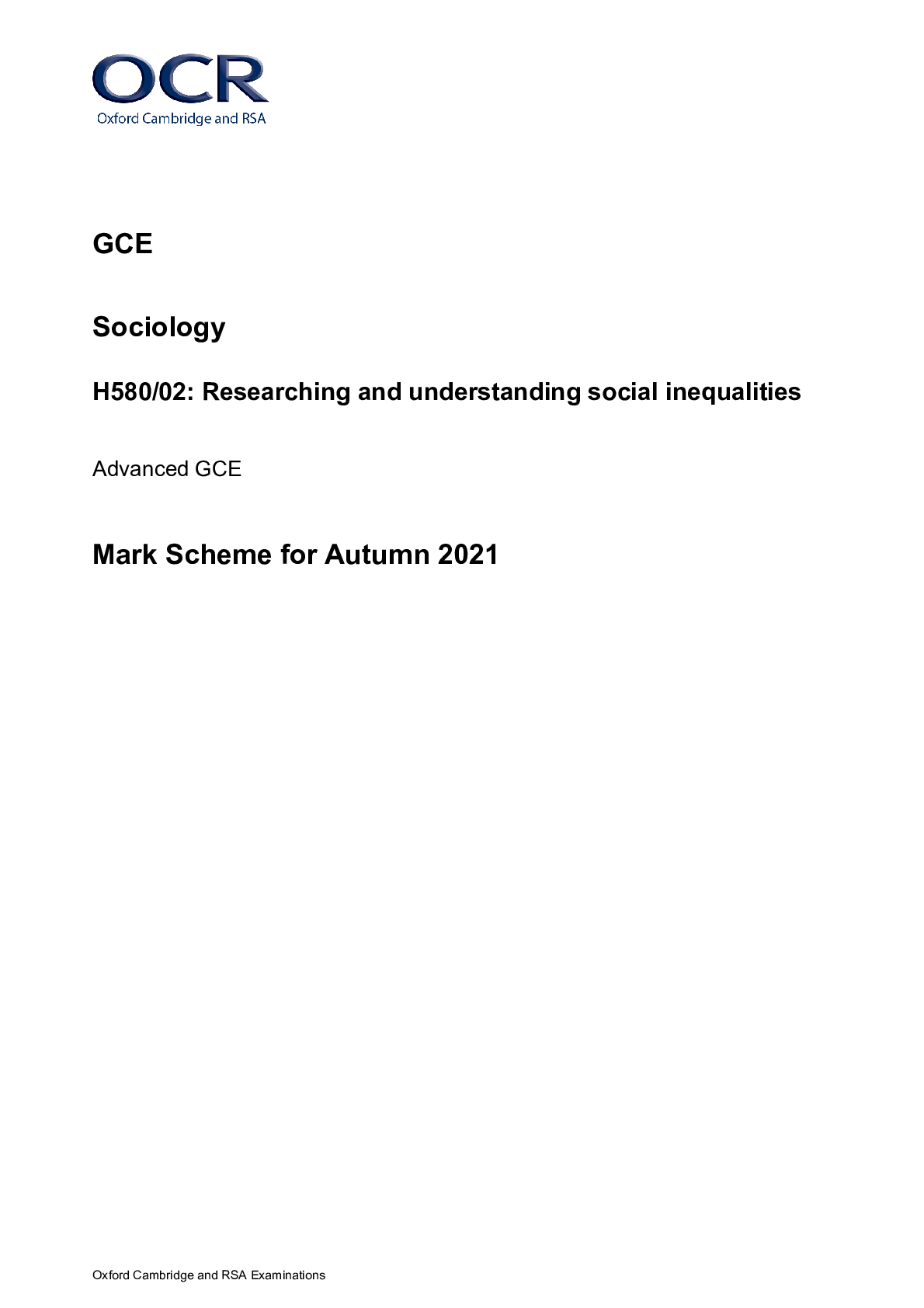




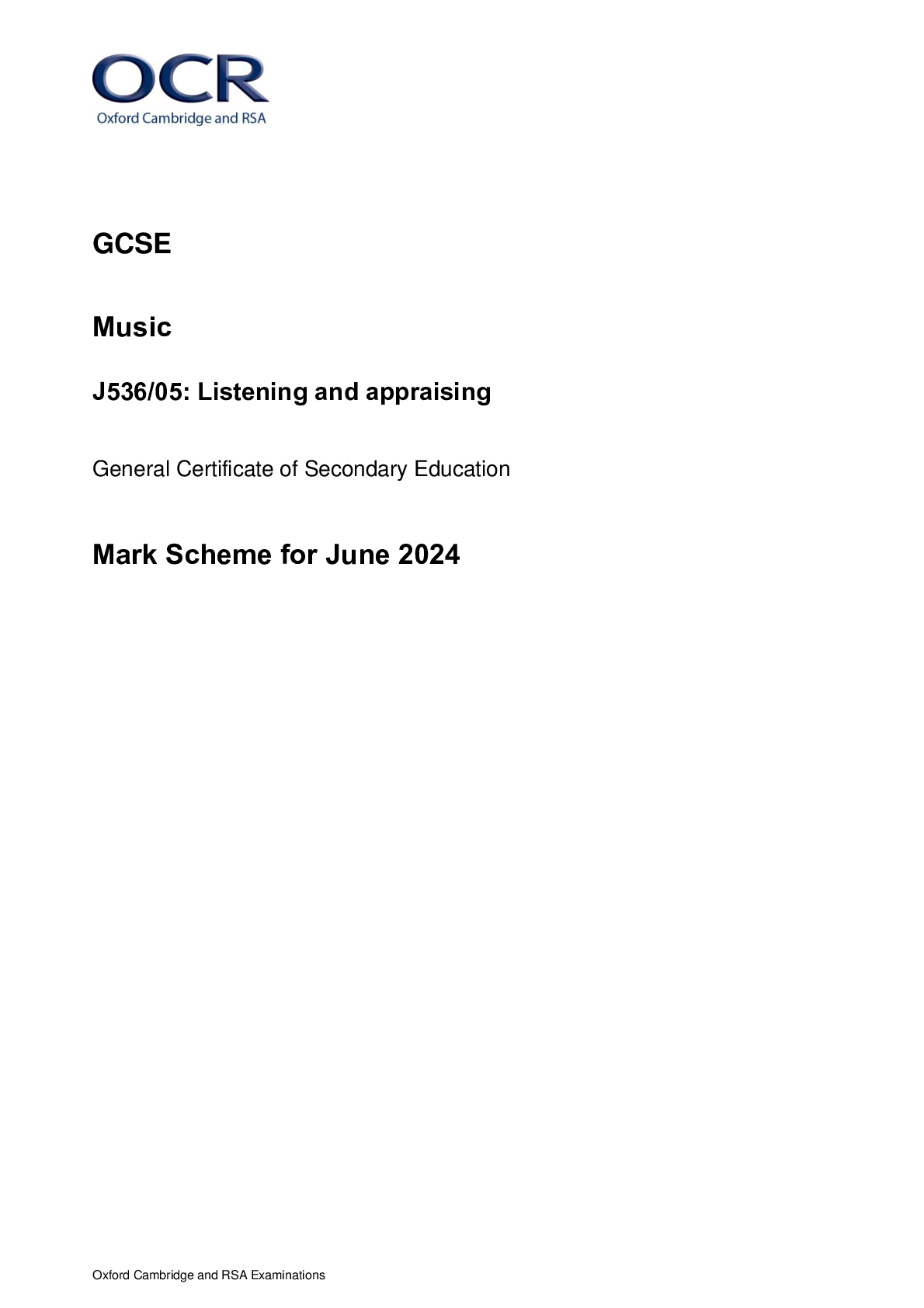

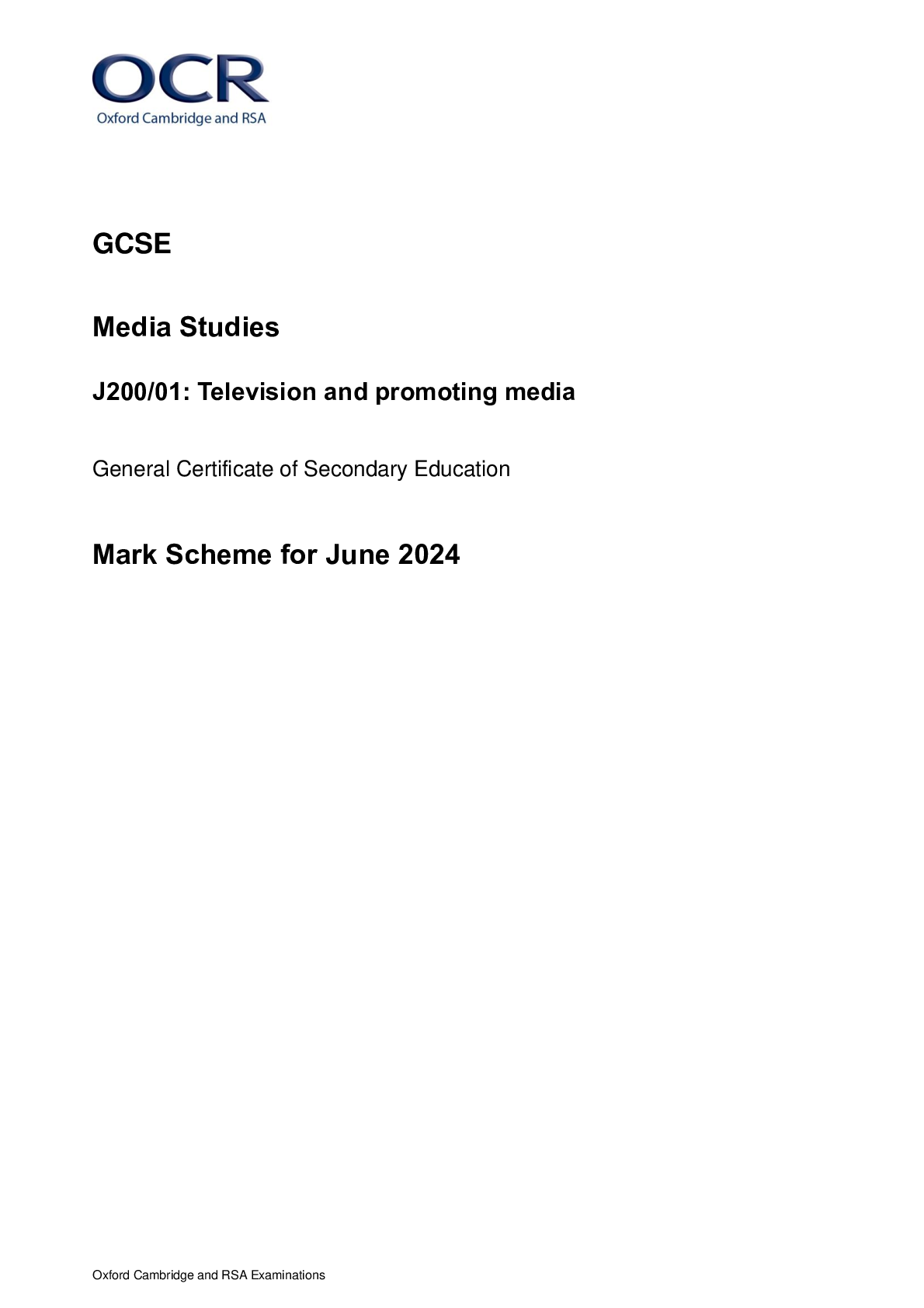
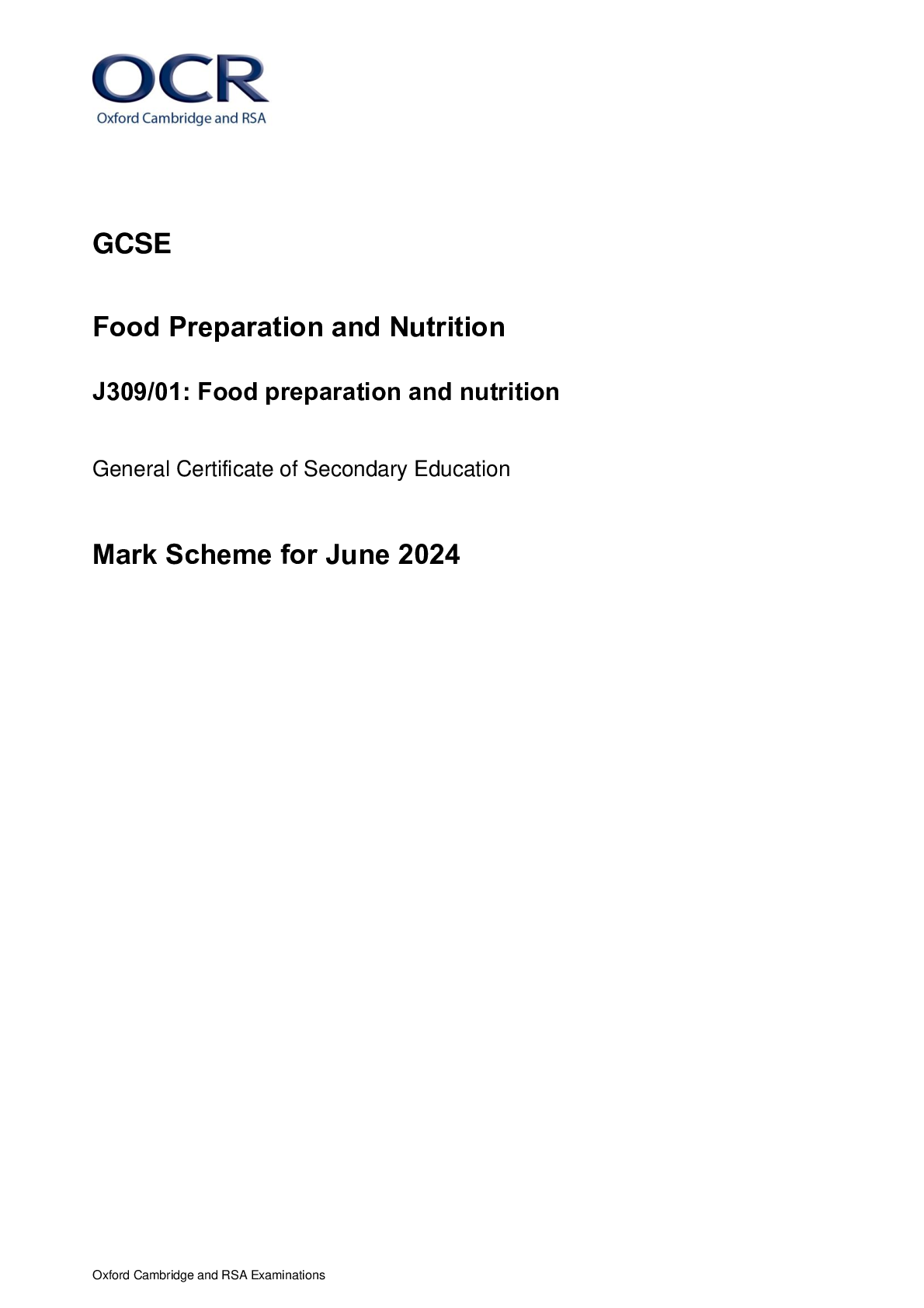
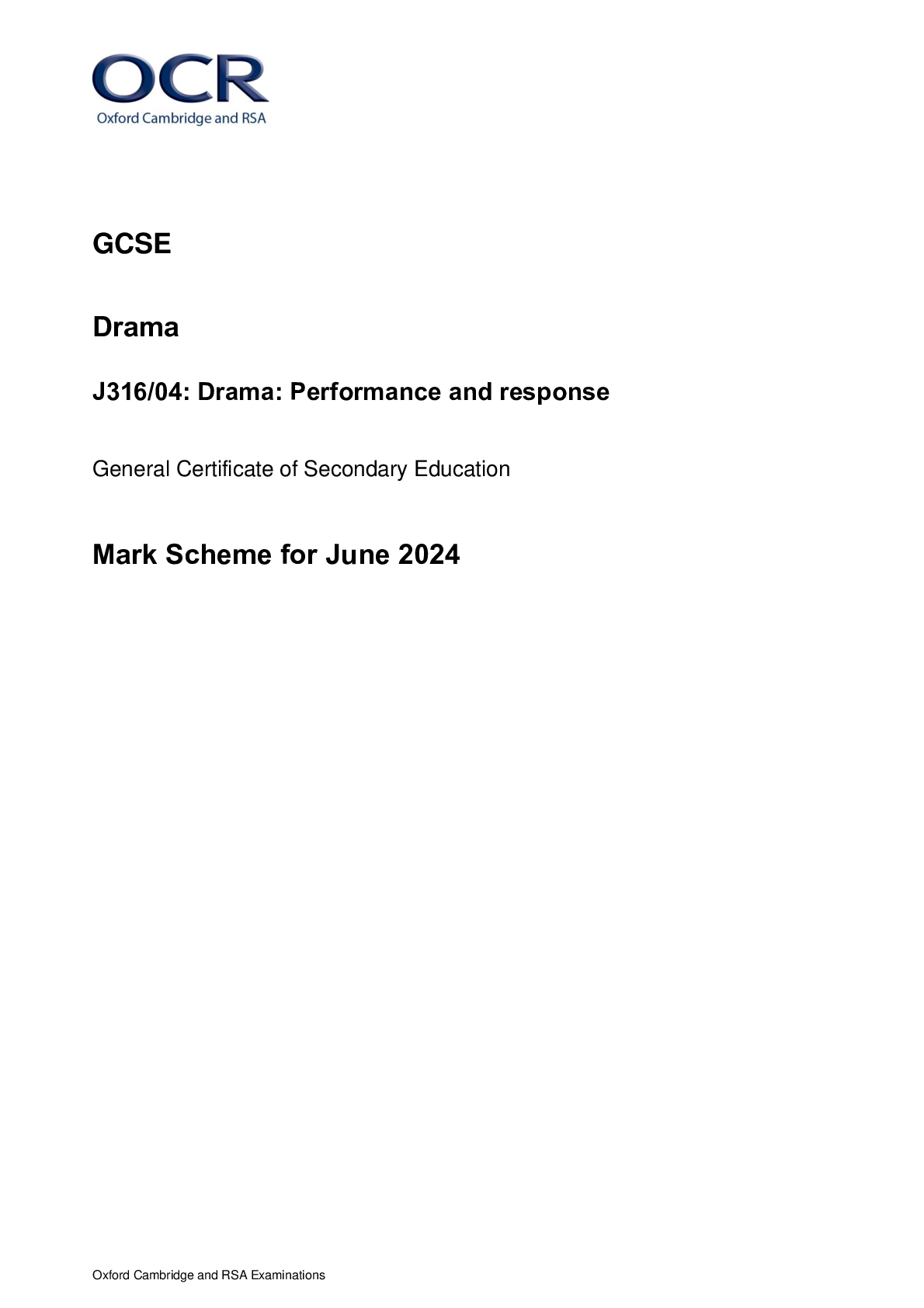
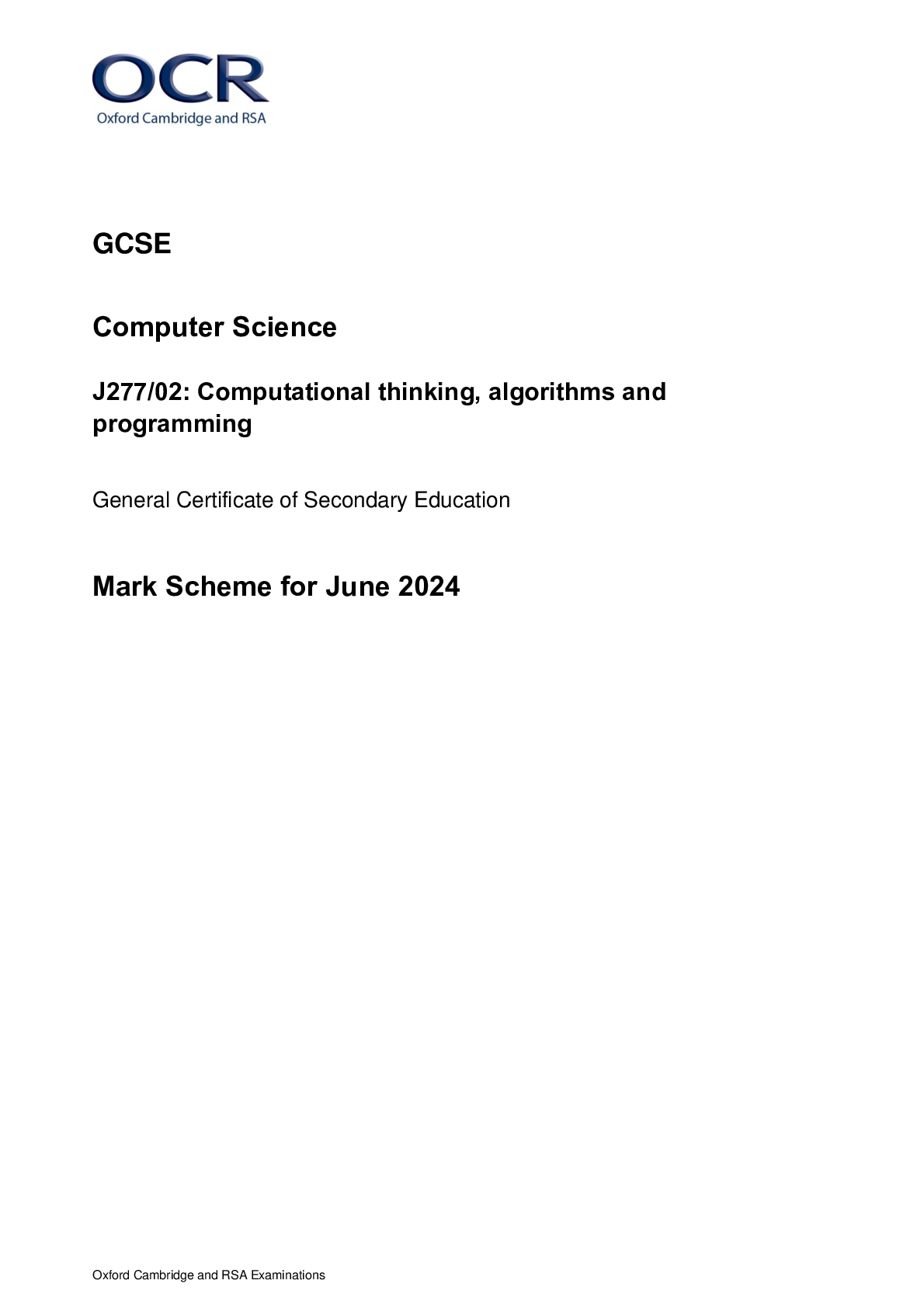
.png)

